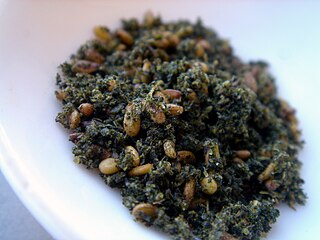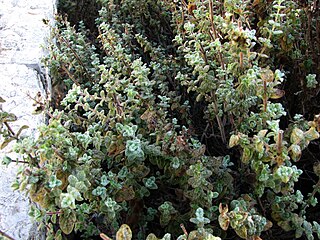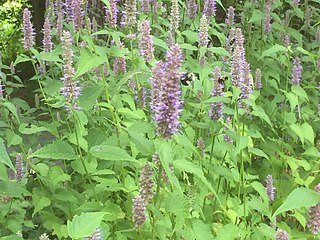
Hyssopus (hyssop) is a genus of herbaceous or semi-woody plants in the family Lamiaceae, native from the east Mediterranean to central Asia as far east as Mongolia. They are aromatic, with erect branched stems up to 60 cm long covered with fine hairs at the tips. The leaves are narrow oblong, 2–5 cm long. The small blue flowers are borne on the upper part of the branches during summer. By far the best-known species is the herb hyssop, widely cultivated outside its native area in the Mediterranean.

The sayings of Jesus on the cross are seven expressions biblically attributed to Jesus during his crucifixion. Traditionally, the brief sayings have been called "words".

Psalm 51, one of the penitential psalms, is the 51st psalm of the Book of Psalms, beginning in English in the King James Version: "Have mercy upon me, O God". In the slightly different numbering system used in the Greek Septuagint and Latin Vulgate translations of the Bible, this psalm is Psalm 50. In Latin, it is known as Miserere, in Ancient Greek: Ἥ Ἐλεήμων, romanized: Hḗ Eleḗmōn), especially in musical settings. The introduction in the text says that it was composed by David as a confession to God after he sinned with Bathsheba.

Za'atar is a culinary herb or family of herbs. It is also the name of a spice mixture that includes the herb along with toasted sesame seeds, dried sumac, often salt, as well as other spices. As a family of related Middle Eastern herbs, it contains plants from the genera Origanum (oregano), Calamintha, Thymus, and Satureja (savory) plants. The name za'atar alone most properly applies to Origanum syriacum, considered in biblical scholarship to be the ezov of the Hebrew Bible, often translated as "hyssop" but distinct from modern Hyssopus officinalis. Used in Levantine cuisine, both the herb and spice mixture are popular throughout the Mediterranean region of the Middle East.

The red heifer, a female bovine which has never been pregnant or milked or yoked, also known as the red cow, was a cow brought to the priests as a sacrifice according to the Torah, and its ashes were used for the ritual purification of Tum'at HaMet, that is, an Israelite who had come into contact with a corpse.

An aspergillum is a liturgical implement used to sprinkle holy water. It comes in two common forms: a brush that is dipped in the water and shaken, and a silver ball on a stick. Some have sponges or internal reservoirs that dispense holy water when shaken, while others must periodically be dipped in an aspersorium.

The Nišava or Nishava is a river in Bulgaria and Serbia, a right tributary, and with a length of 218 km also the longest one, of the South Morava.

Bacopa is a genus of 70–100 aquatic plants belonging to the family Plantaginaceae. It is commonly known as waterhyssop.

Lake Jackson is a shallow, prairie lake on the north side of Leon County, Florida, United States, near Tallahassee, with two major depressions or sinkholes known as Porter Sink and Lime Sink.

Agastache is a genus of aromatic flowering herbaceous perennial plants in the family Lamiaceae. It contains 22 species, mainly native to North America, one species native to eastern Asia. The common names of the species are a variety of fairly ambiguous and confusing "hyssops" and "mints"; as a whole the genus is known as giant hyssops or hummingbird mints.
Parah (Hebrew: פָּרָה) is the name of a treatise in the Mishnah and the Tosefta, included in the order Tohorot. The Pentateuchal law decrees that a red heifer, "wherein is no blemish, and upon which never came yoke," shall be burned and her ashes mixed with spring water, that the compound so obtained may be used to sprinkle and cleanse every one who becomes unclean. The burning of the heifer and the preparation of the ashes, as well as the fetching of the water and its mixture for sprinkling, were attended by strict ceremonies. The treatise Parah contains a detailed description of these ceremonies, as well as various regulations concerning the purity of the water for sprinkling and its different effects.

The Doni Tondo or Doni Madonna, is the only finished panel painting by the mature Michelangelo to survive. Now in the Uffizi in Florence, Italy, and still in its original frame, the Doni Tondo was probably commissioned by Agnolo Doni to commemorate his marriage to Maddalena Strozzi, the daughter of a powerful Tuscan family. The painting is in the form of a tondo, meaning in Italian, 'round', a shape which is frequently associated during the Renaissance with domestic ideas.

Anartia jatrophae, the white peacock, is a species of butterfly found in the southeastern United States, Central America, and throughout much of South America. The white peacock's larval hosts are water hyssop, lemon bacopa, tropical waterhyssop, frogfruit, lanceleaf frogfruit, and Carolina wild petunia . The males of the species display a unique territorial behavior, in which they stake out a territory typically 15 meters in diameter that contains larval host plants. They perch in this area and aggressively protect it from other insects and other male white peacocks.

Ezov is the Classical Hebrew name of a plant mentioned in the Bible in the context of religious rituals. In some English-language Bibles, the word is transliterated as ezob.

Origanum syriacum; syn. Majorana syriaca, bible hyssop, Biblical-hyssop, Lebanese oregano or Syrian oregano, is an aromatic perennial herb in the mint family, Lamiaceae.

Bacopa rotundifolia is a species of water hyssop known as the disk water hyssop or round-leafed water hyssop, due to the shape of its leaves. This is an aquatic plant native to water bodies of the central United States and well known in other areas as an invasive weed of waterways. The round leaves are 1 to 3 centimeters wide and each has six longitudinal veins. The plant produces yellow-throated white flowers. The plant is in bloom during the fall, its fruit/seed abundance is medium and its seed spread rate is slow. The plant has no commercial use.

The Boggs Lake Ecological Reserve is a nature reserve in Lake County, California. The land area is about one quarter of a square mile and contains a large vernal pool as well as endangered plants such as the Boggs Lake hedge-hyssop.

Hyssopus officinalis or hyssop is a shrub in the Lamiaceae or mint family native to Southern Europe, the Middle East, and the region surrounding the Caspian Sea. Due to its purported properties as an antiseptic, cough reliever, and expectorant, it has been used in traditional herbal medicine.

Agastache foeniculum, commonly called anise hyssop, blue giant hyssop, Fragrant giant hyssop, or the lavender giant hyssop, is a species of perennial plant in the mint family, (Lamiaceae). This plant is native to much of north-central and northern North America, notably the Great Plains and other prairies. It is tolerant of deer and drought, and also attracts hummingbirds, butterflies, bumblebees, honey bees, carpenter bees, and night flying moths.

Satureja thymbra, commonly known as savory of Crete, whorled savory, pink savory, and Roman hyssop, is a perennial-green dwarf shrub of the family Lamiaceae, having strongly scented leaves, endemic to Libya, southeastern Europe from Sardinia to Turkey; Cyprus, Lebanon and Israel (Palestine). The plant is noted for its dark-green leaves which grow on numerous, closely compacted branches, reaching a height of 20–50 cm. The plant bears pink to purple flowers that blossom between March and June.


















